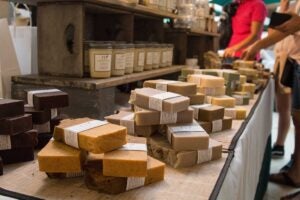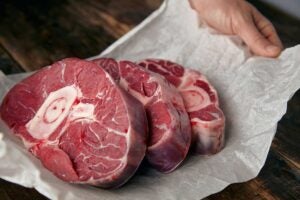Winter on the farm is a slower time. In the spring and summer crops are growing, all the babies are being born, and it’s a grind. That leads into when the majority of farms make their money … during the harvest season. Winter is often a time for planning, decompressing, and spending time with family and friends (maybe moreso for those involved in crops rather than livestock).
But many farmers need to keep revenue streams going throughout the offseason, and the holidays are the perfect time to support them. Here’s how!
Aside from their main crops, many small- and medium-sized farmers also produce value-added products. A value-added product is simply a product made out of the raw products the farmer produces. (If you’re a farmer and you’re reading this, U.S. Department of Agriculture has Value-Added Producer Grants available. Go here for more information.)
Here are some examples of value-added products:
- Soap
- Cheese
- Lotions
- Chapstick
- Essential oils
- Seasonings
- Winter flowers like paperwhites, amaryllis, poinsettias
- Wreaths
- Everlasting flowers (dried flowers put into arrangements that you can keep forever)
- Fiber and yarn
- Animal hides (use them for decoration, floor coverings, blankets, or to make clothing)

Part of winter planning for food subscriptions includes collecting deposits. This is especially valuable to small-scale farmers who are enabled with the deposits to purchase items needed during the growing season, such as tools, seeds, season extenders, and more. Consider purchasing a subscription for yourself or as a gift for a friend or family member. Farmers have gotten more and more creative about subscriptions packages, but some of the basics include:
- Vegetable CSAs (a box of fresh vegetables weekly or bi-weekly)
- Eggs
- Flower arrangements
Farmers and ranchers who raise animals often begin the process in the winter as well. There are breeding plans, grazing plans, vaccination plans, and more. Look to those farmers for purchasing local protein like:
- Beef (a quarter, half, or whole beef)
- Pork (half or whole hog)
- Poultry

You can also consider buying holiday protein from your local farmer. Make sure you are talking to your farmer well in advance of the holiday, this way the product can be raised just for you!
Farmers often offer classes on farming, like soil health or seed propagation, which are great for you or as a gift. Purchase two places and take the class with a friend! Flower farmers might offer classes like wreath making or flower arranging. Other classes farmers offer might include:
- Cooking
- Seed saving
- Farm planning
- Butchering
And lastly, many farmers choose to convert parts of their land or buildings into event spaces for family reunions, weddings, and more. Utilize event spaces offered by farmers on their land.
During the holidays and gift-giving season, retail sales tend to increase. But if you like to keep your money in your community, there are so many ways to keep supporting local farmers and ranchers, even in the off-season. You can find these producers through social media or simply looking them up in an internet search engine. One of my tricks to find other producers is to go to the local farmers market webpages, see which farms are vendors there, and then reach out to them directly! Farmers need your support this gift-giving season so consider keeping your dollars in your community and lifting a local farmer or rancher up!
Farm on!
Brianna Scott is a veteran farmer who lives in Eastern Washington and earned her Master’s of Science in Agriculture from Washington State University. She is active in the veteran ag community and raises poultry and livestock while growing a large market garden.



